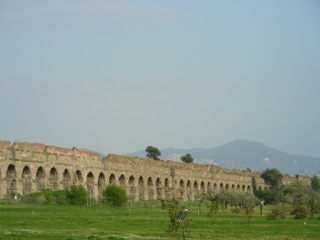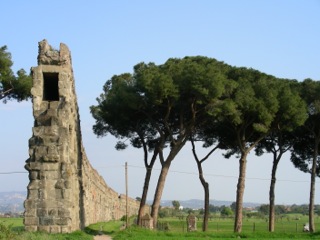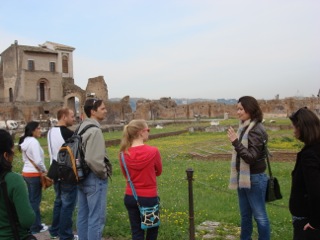This is a guest post written by Agnes from understandingrome.com and I want to thank her for this insightful post as it was also an eye-opener for me. If you want to go off the beaten path, this would be a fascinating tour.
 In 312 BC the censor Appius Claudius decided to harness the natural springs in the Alban Hills south of Rome, and bring the waters into town using the force of gravity. A man full of big ideas he began building the Appian Way in the same year, and quickly the Romans realized he was on to a good thing.
In 312 BC the censor Appius Claudius decided to harness the natural springs in the Alban Hills south of Rome, and bring the waters into town using the force of gravity. A man full of big ideas he began building the Appian Way in the same year, and quickly the Romans realized he was on to a good thing.
Roads sprung up in every direction, and over the next five hundred years a total of 14 aqueducts were constructed. By the peak of Empire in the early 2nd century AD it is estimated that 1cubic metre (c. 250 gallons) of water per person per day entered a city of over a million inhabitants. Per capita that’s more water than has provided any city. Ever.
This ingenious exploitation of the reserves in the extinct volcanoes to the south and the north of Rome (all of those lakes dotting the map were once craters), and the limestone hills to the east of the city, played a vital role in the city’s population explosion.
It meant that water could be employed for more than the everyday requirements of survival, and the bath complexes were born. Using furnaces, fuelled by the oak forests once native to the city’s surrounds and manned by vast numbers of unfortunate slaves, and of course all of that water, it was possible to recreate the natural thermal springs so beloved of the Greeks whereever the whim struck, not only where nature decreed.
The best preserved section of aqueduct in Rome is part of the Aqua Claudia, the largest to be built in the city, and is best seen at the Parco dei Acquedotti.
As the name suggests it’s a park with bits of aqueducts meandering through. To visit take the Metro Line A (the red one) south of the centre to Giulio Agricola, and walk south along Viale Giulio Agricola. At the end pass the 1960s church of St Polycarp, and bear left as you enter the park.
The first section of aqueduct you come across is the lower (and less exciting) Aqua Felice, a Renaissance rebuilding of the 3rd century AD Aqua Alessandrina. Keep heading south and you’ll soon see the great arches of the Aqua Claudia (pictured) looming ahead.
Begun by the Emperor Caligula in 38 AD (350 years after Appius Claudius had commissioned the first aqueduct) and completed by Claudius 14 years later, it is in fact two aqueducts, a ‘double-decker’ supported on the same set of arches.
The upper ‘specus’ (channel), now mostly missing, was the Anio Nuovo, the lower (clearly visible in the photo below) is the Aqua Claudia. Both have their sources in the hills near Tivoli, some 25 miles east of Rome.

The better documented of the two, the Aqua Claudia, ran a total of 45 miles, maintaining a constant gradient of 1:256. So the water came from 25 miles away but ran 45 miles to get to Rome?
Well, the Romans built their roads straight, but not their aqueducts. They maximize efficiency by keeping to the high land. In fact of the Aqua Claudia’s 45 miles only 12 are above ground, and the majority of aqueducts were channeled underground, with arches only being built when the hillside dropped away more steeply than the intended gradient.
This explains why the aqueduct appears to snake into Rome from the south; that was the closest that the hills get to Rome. Then and where there was no option but to build arches which are at points 30 m above ground, and why build two sets of arches?

Appius Claudius was full of good ideas, he also began building the “Viarum reginam” (Queen of Roads), the Appian Way. Understandingrome.com suggests an itinerary combining the Baths of Caracalla, the Appian Way, and the Aqueduct Park for an overview of the infrastructures which made Rome’s growth possible.
To get to know more about Agnes, read the interview she did with Browsing Rome.
 BrowsingRome Blogging about my experiences and sharing my thoughts about Rome, Italy and beyond
BrowsingRome Blogging about my experiences and sharing my thoughts about Rome, Italy and beyond
What a great post! I want to do this tour too!!
Hi Sarah,
We should ask Agnes if she can arrange a group tour as I am sure there are others who would be keen to do it too. What do you think?